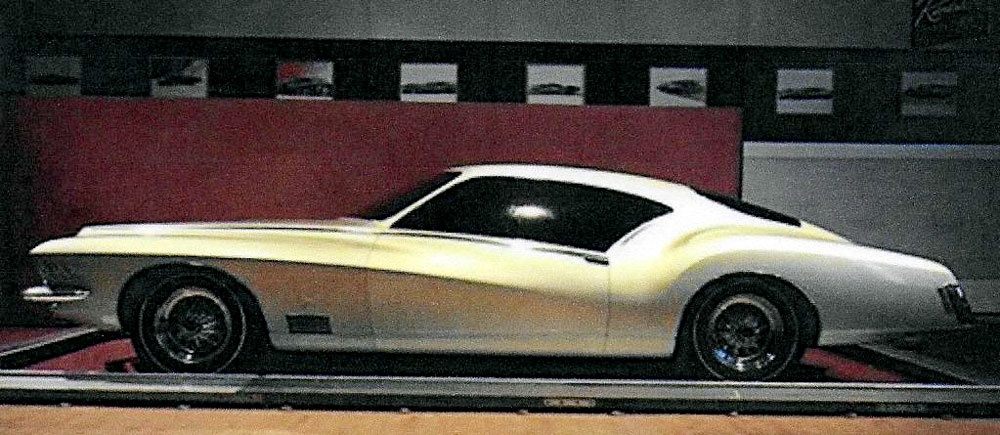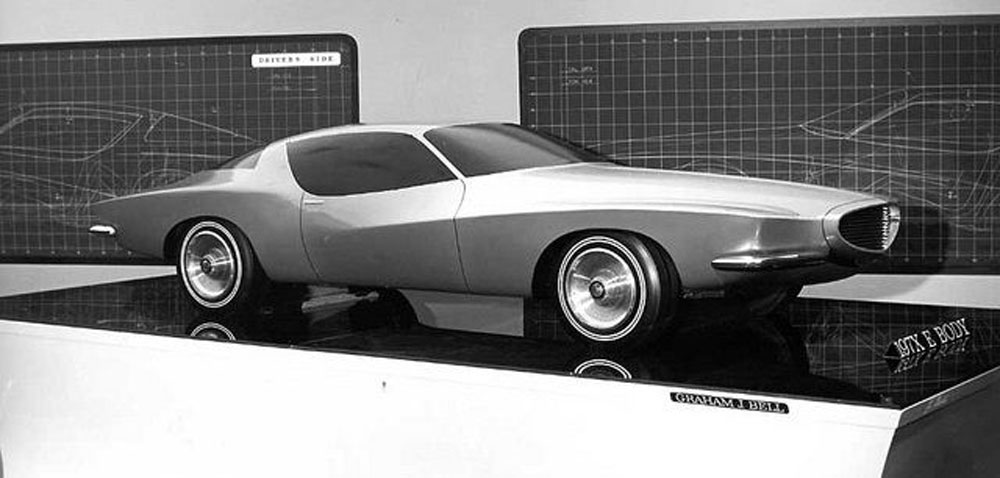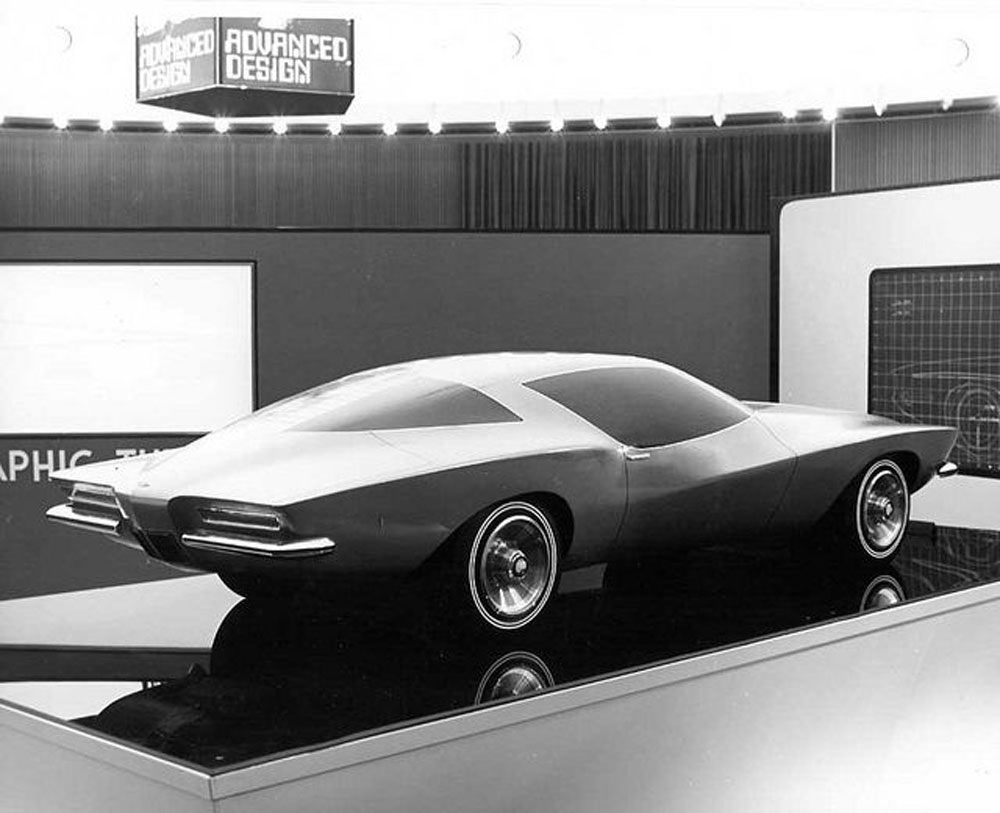1971 Boat-Tail Riviera A-body
By Bruce Brooks
In early 1968 I transferred from Dick Ruzzin’s Adv. Oldsmobile Studio to Jerry Hirshberg’s Adv. Buick Studio which was on the north east end of the second floor of the Design Staff Building. At that same time Doug Cross also transferred there from Chevrolet 2 Studio.
We transferred there to add to the clay modeling team that consisted of Frank Hughes, Frank Funk, Ben Vitale and Joe Henelt. Joe only worked on the 3/8th scale models. We were tasked with the sculpting of Bill Mitchell’s first design of the 1971 Boat-Tail Riviera. The clay armature was built to what were A-Body dimensions and configuration.
At that time Hirshberg’s design team consisted of Len Casillo, Jerry Palmer, Tom Hale and Joan Klatil. They all did a great job of executing special details in design direction.
The engineering team consisted of Tom Krauzowicz and Mike Fylan.
Mitchell’s “Sweep Spear” design theme came the full length of the hood past the A-pillar without a break, across the door belt line to a graceful arc ending under the rear quarter window. The whole design impact of the models lines, shapes, and surfaces gave a feeling that the proportions were just right. We photographed the finished clay model in the studio with silver and black Di-Noc and foil trim late in April of 1968 for a Buick Division management concept review.
Unfortunately GM Corporate management put a change of direction in front of Mitchell to have the car done to a B-Body dimension. With great regret Bill knew that change would compromise the beauty of the car’s “Sweep Spear” design theme. That decision was a huge mistake by upper GM management and I feel that led to the cars’ short life and ultimate demise. From sleek to lead-sled, nice move.
With that new direction Casillo and Palmer transferred to other studios and Tom Hale departed GM Design. We did add John Houlihan’s design talent from Preliminary Design Studio.
Our studio had to immediately start a new direction with the build of a B-Body clay armature placed in a rail located across the hall in a temporary studio next to Adv. Oldsmobile Studio. We just knew that the “Sweep Spear” theme would not be able to make it past those wide A-pillars of the B-Body armature and not have a considerable break in plan view. That theme idea ended there. We continued work on the new direction and in 1969 the armature was transferred with the remainder of our studio personnel down to our new Advanced Two Design Studio on the first floor where the old shops once were. After a short time there the 1971 B-Body Boat-Tail Riviera was sent to Buick Exterior Design Studio for a final production release.
I will enclose a scanned photo of the finished first 1971 Buick Riviera Boat-Tail design direction of the A-Body clay model as it looked in the studio for the Buick Division review.
Thanks, Bruce. More great studio stories by Bruce Brooks to come.
Lots more studio shenanigan stories in the Dean’s Garage Book.




I remember seeing the finished model and thought it was especially nice with great proportion and scale. A “total” design theme that was not superficial or driven by internal packaging criteria as it appeared.
Graham’s model is another that has a great form language that was unique. The final car that was later done in Buick Studio was sorely lacking in aesthetic character compared to the easy car.
What was the differences from the A body to the B body?
Different platforms were given letter designations. Platform groups would share a lot of body construction components, like door inners, uppers (windshield, roof, side glass), chassis sheet metal, frames, cowl, etc.. to save costs.
Back in the day B-bodies would include Chevy Impala/Caprice, Pontiac Catalina, Olds 88, and Buick LeSabre. A-Bodies are smaller: Chevy Malibu, Pontiac Tempest, Olds Cutlass, Buick Skylark.
So the designers all lamented the fact that the Boattail RiV was scaled up from a reasonable, sporty size to a platform that really was too big for the design.—Gary
Bruce, thank you for the interesting story and images. The A-Body Riviera would have been a much better design. Two follow-up questions.
First, did management explain why they went with the B-Body instead? One thing I’ve wondered is whether the new-generation A-Body was far enough along in its development that the Riviera could have used it in 1971. Was the initial plan for an A-Body Riviera to come out in 1972? It has always struck me as odd that GM would completely reskin the Riviera in 1970 for one year only.
Second, did GM consider putting the Riviera on the F-Body? The fastback boat-tail shape could have been quite interesting on that platform.
Steve S,
Back in the day GM would often do a slight tooling change for the last year of a generational run. Take for example, the 67-68 Camaro saw only minor changes, but the 69 had more sculpture, the 63-64 Riv were almost identical, but the 65 got its own treatment. We have to remember it was only a decade before when GM would literally change body panels every year, the 55-56-57 Chevy is a great example. With the advent of crash testing and regulations that squashed creativity, add to that the increasing costs of production and overseas competition it became more difficult to do those one production changes. Even the Boat tail 71-72 Riv were quite similar, the 73 was more unique in comparison.
In part GM probably calculated that the tooling paid for itself during the multiple years, and doing a single year run was worth the small investment.
Another key factor is when designers and engineers ran GM, arguably they made some of the most beautiful cars. When bean counters took over is when you noticed a shift in style, and that generic look. Simply look to the mid 70’s where if you removed the emblems and bumpers from a Cadillac, Buick or Olds, you could not tell which one was which.
Steve S. above mentioned the 1970 Riv. Was that a re-skin for one year only, or a clever manipulation of style adding fender skirts? The ’70 Riviera certainly looked smaller to me at first blush than it’s predecessors, but I’m not sure it was. Fascinating to think what could have been with a Riviera as a direct personal lux competitor to the Monte Carlo and Grand Prix, the later of which shrunk in 1970, if I’m not mistaken. Size was king in terms of luxury perception in that era, and to some degree I can see why GM would direct Buick and Olds to have larger personal luxury offerings. Thanks! Great page.
It’s a very interesting take on the Riviera. I for one am glad they used the B-body for the boat tail and I think the production car is one of the most beautiful designs ever. I also shudder to think that the 71 Eldorado was almost smaller. I love the big ones and there’s no need to apologize for the size.
Unlike many of the artists here, I actually built Chevrolets, at the GMAD facility at Tarrytown NY. So re: personal luxury cars and chassis, one year we saw a new body being towed across the line floor…we asked what it was. Guy with the fork lift says “Read the label”. It said “Monte Carlo”. We all said, “What’s that?”. Later, we saw a semi complete version with the hood open. The grille looked like it was three feet ahead of the motor, to fit it onto the Chevelle chassis. One of our guys looked at all the excess room and said “What goes in there between the motor and the grille?”. Another example of fitting a body to a chassis that wasn’t exactly the right fit.
The 1971 boat-tail Riv was a missed opportunity. I remember looking at one for the first time at the Flint Buick dealership where my dad worked. Even to my teenaged eyes, there was something “off” with the proportions – particularly in the rear quarters just behind the doors. Thanks for answering the question I always had about this design. It would have been so much better had it not been scaled up.
I have always heard that Buick General Manager Lee Mays said that Buick’s most prestigious car would be a full-sized car, period. There was no love lost between he and Mitchell. They fought over it and Mays won. Also remember Mitchell saying in a later interview, “The first time I saw the B Body version I thought they’d turned a speed boat into a tug boat.”
Thanks for this story. I only saw the smaller boattail Riv once in the hallway and it was really good nostalgia. As for the 1970 Riv, I worked on it in Buick studio. The car is a facelift of the 1968-9 car with the exposed headlights and grille under the carryover hood and fenders; New rear quarter and back glass. Mitchell had customized a Riviera adding the sweepspear and skirts, which went on the car. I did the taillight design-one mockup, straight to engineering and i never saw it again until it was in the showroom! crazy times…..
Over the past five years I have lovingly restored a ’71 Boat Tail Riviera. It is painted a very light silver tone with the slightest hint of very fine metal flake. It has coil overs that QA-1 helped me to develop for all four corners that have allowed it to be lowered uniformly about 4-inches.
I suppose beauty is in the eye of the beholder, as to my eyes it is simply the sexiest thing ever to roll out of Detroit, in any age.